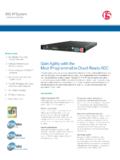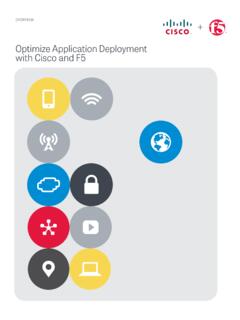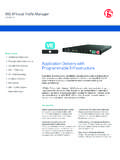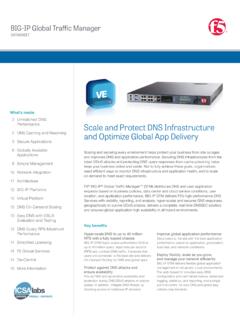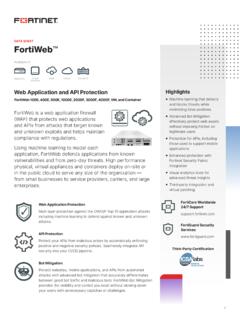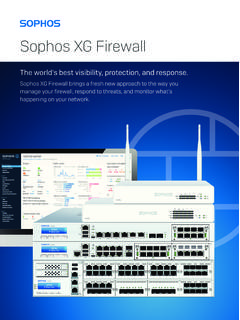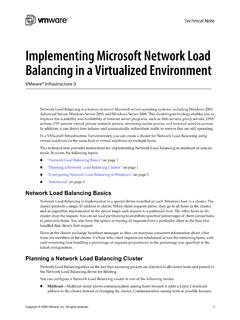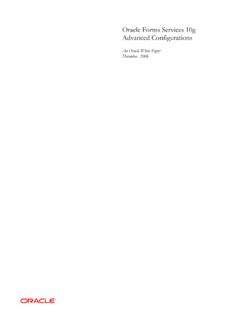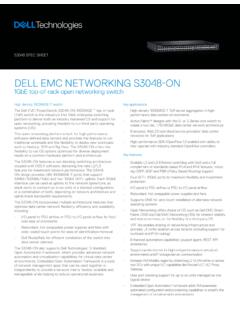Transcription of Deploying F5 with Microsoft Exchange 2016 Mailbox …
1 Deploying F5 with Microsoft Exchange 2016 Mailbox Servers Welcome to the F5 and Microsoft Exchange 2016 deployment guide. Use this document for guidance on configuring the BIG-IP system version 11 and later to provide additional security, performance and availability for Exchange Server 2016 Mailbox servers. When configured according to the instructions in this guide, whether using an iApp template or manually, the BIG-IP system performs as a reverse proxy for Exchange Mailbox servers, and also performs functions such as load balancing , compression, encryption, caching, and F5?F5 offers a complete suite of application delivery technologies designed to provide a highly scalable, secure, and responsive Exchange deployment. The BIG-IP LTM can balance load and ensure high-availability across multiple Mailbox servers using a variety of loadbalancing methods and priority rules.
2 Terminating HTTPS connections at the BIG-IP LTM reduces CPU and memory load on Mailbox Servers, and simplifies TLS/SSL certificate management for Exchange 2016 . The BIG-IP Access Policy Manager (APM), F5's high-performance access and security solution, can provide pre-authentication, single sign-on, and secure remote access to Exchange HTTP-based client access services. The BIG-IP Advanced Firewall Manager (AFM), F5's high-performance, stateful, full- proxy network firewall designed to guarddata centers against incoming threats that enter the network can help secure and protect your Exchange deployment. The BIG-IP LTM TCP Express feature set ensures optimal network performance for all clients and servers, regardless ofoperating system and version. The LTM provides content compression features which improve client and versionsProductVersionMicrosoft Exchange Server2016 (for previous versions of Exchange , see )BIG-IP systemManual configuration: - template: - iApp and Guide versionLast See Document Revision History on page 128 for revision details10-24-2019 Important: Make sure you are using the most recent version of this deployment guide, available at For previous versions of this and other guides, see the Deployment guide Archive tab on : : This guide has been archived.
3 While the content in this guide is still valid for the products and version listed in the document, it is no longer being updated and may refer to F5 or 3rd party products or versions that have reached end-of-life or end-of-support. See for more Deployment Guide Microsoft Exchange Server 20162 ContentsIntroduction 3 What is F5 iApp? 3 Prerequisites and configuration notes 4 Configuring the iApp for Exchange Hybrid deployments 7iApp Deployment Scenarios 8 Local BIG-IP system load balances and optimizes traffic 8 Local LTM receives HTTP-based traffic forwarded by a remote APM 9 Local APM secures and forwards traffic to a remote LTM 10 Preparation worksheets 11 Configuring the BIG-IP system for Microsoft Exchange using the iApp template 13 Downloading and importing the new iApp 13 Upgrading an Application Service from previous version of the iApp template 13 Getting started with the Exchange iApp template 13 Configuring the local LTM to receive HTTP-based traffic forwarded by a remote APM 39 Configuring a local APM to secure and forward traffic to a remote LTM 55 Modifying the iApp configuration 65 Next steps 66 Troubleshooting
4 68 Appendix A: Configuring additional BIG-IP settings 78 Appendix B: Using X-Forwarded-For to log the client IP address 79 Appendix C: Manual configuration tables 81 Configuration table if using a combined virtual server for Exchange HTTP-based services 81 Configuration table if using separate virtual servers for Exchange HTTP-based services 84 BIG-IP APM manual configuration 98 Optional: Securing Access to the Exchange Administration Center with BIG-IP APM 109 Optional: Configuring the APM for Outlook Anywhere with NTLM Authentication - BIG-IP or later only 113 Manually configuring the BIG-IP Advanced Firewall Module to secure your Exchange deployment 118 Appendix D: Technical Notes 123 Appendix E: Active Directory and Exchange Server configuration for NTLM 125 BIG-IP APM/LTM without DNS lookups 127 Document Revision History 128 ArchivedF5 Deployment Guide Microsoft Exchange Server 20163 IntroductionThis document provides guidance for using the updated, downloadable BIG-IP iApp Template to configure the Mailbox server role of Microsoft Exchange Server, as well as instructions on how to configure the BIG-IP system manually.
5 This iApp template was developed for use with Exchange Server can configure the BIG-IP system to support any combination of the following services supported by Mailbox servers: Outlook Web App (which includes the HTTP resources for Exchange Control Panel), Exchange Web Services, Outlook Anywhere (RPC over HTTP, including the Offline Address Book), ActiveSync, Autodiscover, POP3, IMAP4, and MAPI over HTTP. For more information on the Exchange 2016 see: (v= ).aspxFor more information on the F5 devices in this guide, see can also see the BIG-IP deployment guide for SMTP services at: can also visit the Microsoft page of F5 s online developer community, DevCentral, for Microsoft forums, solutions, blogs and more: provide feedback on this deployment guide or other F5 solution documents, contact us at is F5 iApp?F5 iApp is a powerful set of features in the BIG-IP system that provides a new way to architect application delivery in the data center.
6 IApp includes a holistic, application-centric view of how applications are managed and delivered inside, outside, and beyond the data center. The iApp template for Microsoft Exchange Server acts as the single-point interface for building, managing, and monitoring the Exchange 2016 client access role. For more information on iApp, see the White Paper F5 iApp: Moving Application Delivery Beyond the Network: ahead AdvancedIf you are already familiar with the Exchange iApp, you can skip directly to the relevant section after reading the prerequisites: Configuring the BIG-IP system for Microsoft Exchange using the iApp template on page 13 if using the iApp template, or Appendix C: Manual configuration tables on page 81 if configuring the BIG-IP system Deployment Guide Microsoft Exchange Server 20164 Prerequisites and configuration notesUse this section for important items you need to know about and plan for before you begin this deployment.
7 Not all items will apply in all implementations, but we strongly recommend you read all of these items BIG-IP system prerequisites h The configuration described in this deployment guide is supported by F5 Networks. F5 Technical support can help validate the configuration described in this guide if necessary, but your environment may have other factors which may complicate the configuration. If you need additional guidance or help with deployment scenarios or configurations that are not included in this guide, we recommend you consult your F5 FSE, check DevCentral ( ) and AskF5 ( ), or contact F5 Professional Services ( ) to discuss a consulting engagement. If you believe you have found an error in this guide, contact us at h For this deployment guide, the BIG-IP system must be running version or later. If you are using a previous version of the BIG-IP system, see the Deployment Guide index on This guide does not apply to previous versions.
8 H Most of the configuration guidance in this document is performed on F5 devices. We provide a summary of Exchange configuration steps for reference only; for complete information on how to deploy or configure the components of Microsoft Exchange Server, consult the appropriate Microsoft documentation. F5 cannot provide support for Microsoft products. h If Deploying BIG-IP APM features, you must fully license and provision APM before starting the iApp template. h This document provides guidance on using the Exchange iApp template. Additionally, for users familiar with the BIG-IP system, there are manual configuration tables at the end of this guide. Because of the complexity of this configuration, we strongly recommend using the iApp to configure the BIG-IP template prerequisites and notes h This document provides guidance on using the F5 supplied downloadable iApp template for Microsoft Exchange 2016 available via , with detailed information and download instructions on AskF5: You must use a downloadable iApp for BIG-IP versions and later.
9 For the iApp template, you must be using version or later as it contains a number of fixes and enhancements not found in the default iApp, or other downloadable versions. ! Warning To run the Microsoft Exchange iApp template, you must be logged into the BIG-IP system as a user that is assigned the admin role. For more information on roles on the BIG-IP system, see the BIG-IP User Accounts chapter of the BIG-IP TMOS: Concepts guide. h BIG-IP APM and later now supports the MAPI over HTTP transport protocol (introduced in Exchange 2013 SP1 and included in 2016 (v= ).aspx). If you are using BIG-IP APM , the iApp template does not support this new protocol. See Manually configuring MAPI over HTTP in Exchange on page 92 for manual instructions on configuring the BIG-IP system for MAPI over HTTP for the versions. h If you have existing, manually created Node objects on the BIG-IP system and given these nodes a name, you cannot use the IP addresses for those nodes when configuring the iApp.
10 You must first manually delete those nodes and re-add them without a name, or delete the nodes and let the iApp automatically create them. h For some configuration objects, such as profiles, the iApp allows you to import custom objects you created outside the template. This enables greater customization and flexibility. If you have already started the iApp template configuration and then decide to you want to create a custom profile, you can complete the rest of the template as appropriate and then re-enter the template at a later time to select the custom object. Otherwise you can exit the iApp immediately, create the profile, and then restart the iApp template from the beginning. h Be sure to see Troubleshooting on page 68 for troubleshooting tips and important configuration changes for specific situations. SSL certificate and key prerequisites and notes h If you are using the BIG-IP system to offload SSL or for SSL Bridging, we assume you have already obtained an SSL certificate and key, and it is installed on the BIG-IP LTM system.


